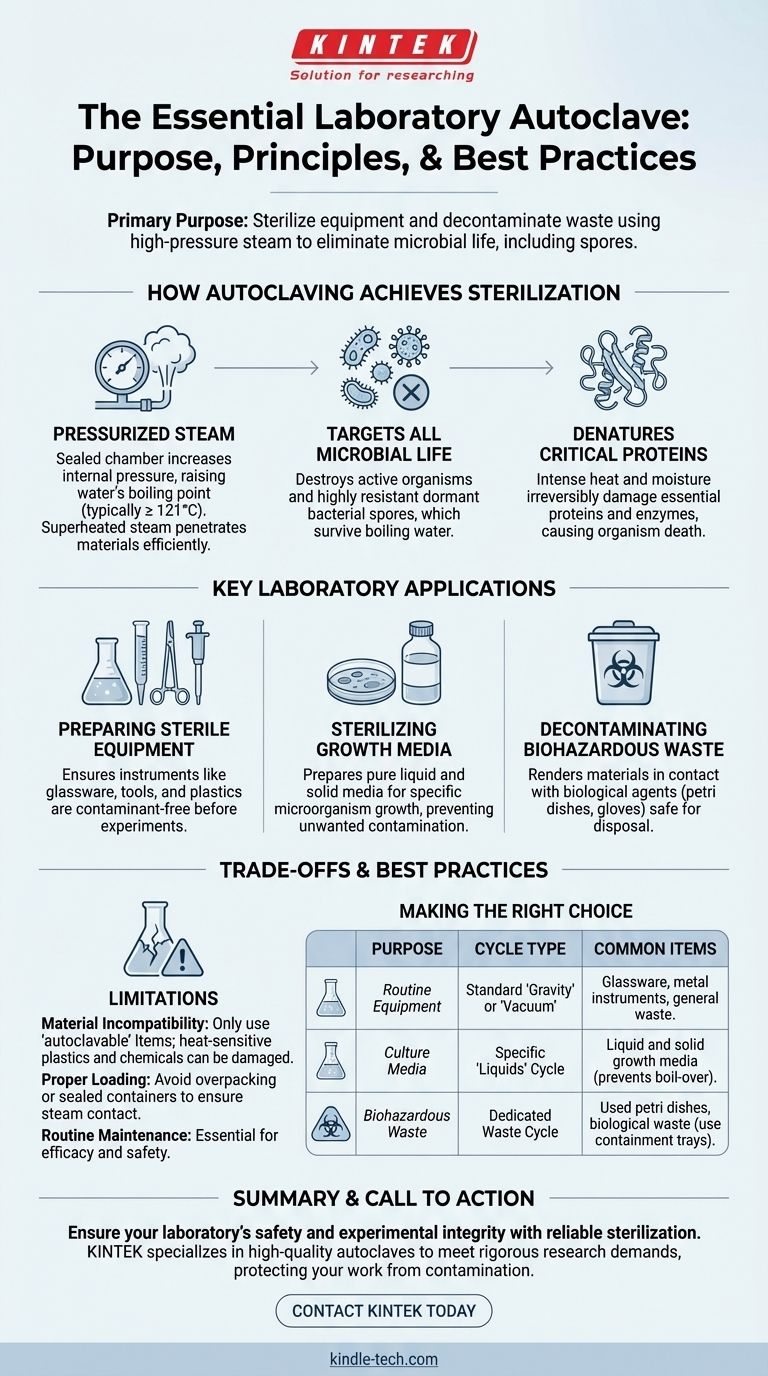In the laboratory, the primary purpose of an autoclave is to sterilize equipment and decontaminate waste. It uses high-pressure steam to achieve temperatures that are lethal to all forms of microbial life, including bacteria, viruses, fungi, and even the most heat-resistant bacterial spores. This process ensures that instruments are free from contaminants before an experiment and that biohazardous materials are rendered safe for disposal.
The autoclave is not just a high-temperature oven; it is the gold standard for sterilization because pressurized steam can penetrate materials and achieve temperatures (typically 121°C or higher) that reliably destroy the toughest microorganisms, something boiling water or simple detergents cannot accomplish.

How Autoclaving Achieves Complete Sterilization
The effectiveness of an autoclave hinges on the precise application of steam, heat, and pressure. This combination creates an environment that is incompatible with any form of life.
The Principle of Pressurized Steam
Under normal atmospheric pressure, water boils at 100°C (212°F). An autoclave is a sealed chamber that increases the internal pressure, which in turn raises the boiling point of water.
This superheated, pressurized steam is a far more effective sterilizing agent than dry heat because it can efficiently penetrate materials and transfer thermal energy.
The Target: All Microbial Life
The goal of sterilization is the complete elimination of viable organisms. Autoclaving is exceptionally effective at this because it destroys not only active bacteria and viruses but also their dormant, highly resistant forms known as spores.
These spores can survive harsh conditions, including boiling, but cannot withstand the sustained high temperatures and moisture of an autoclave.
Denaturing Critical Proteins
The combination of intense heat and moisture rapidly denatures the essential proteins and enzymes that all microorganisms rely on to function and reproduce. Once these proteins are irreversibly damaged, the organism dies.
Key Applications in the Laboratory
Autoclaves are indispensable for maintaining safety and preventing cross-contamination in a scientific setting. Their use falls into three main categories.
Preparing Sterile Equipment
Before conducting experiments, especially in microbiology or cell culture, all instruments must be sterile. This includes glassware, surgical tools, pipette tips, and autoclavable plastics.
Sterilizing Growth Media and Solutions
Scientists use autoclaves to sterilize the liquid and solid media used to grow microorganisms. This ensures that only the specific organism of interest will grow, preventing contamination from unwanted environmental microbes.
Decontaminating Biohazardous Waste
After experiments are complete, any materials that came into contact with biological agents (like petri dishes or used gloves) are considered biohazardous waste. Autoclaving this waste kills any potentially infectious agents, rendering it safe for standard disposal.
Understanding the Trade-offs and Limitations
While powerful, an autoclave is not a universal solution and requires careful operation to be effective and safe.
Material Incompatibility
Not all materials can withstand the high heat and pressure of an autoclave. Heat-sensitive plastics can melt, and certain chemicals or sharp instruments may be damaged. It is critical to only autoclave items designated as "autoclavable."
The Importance of Proper Loading
For sterilization to be successful, steam must make contact with every surface. Overpacking the chamber or using sealed containers can create air pockets that prevent steam penetration, resulting in incomplete sterilization.
The Need for Routine Maintenance
An autoclave is a high-pressure vessel and must be treated with respect. Regular inspections and maintenance by qualified personnel are essential to ensure both its sterilizing efficacy and its operational safety for all lab members.
Making the Right Choice for Your Goal
To ensure safety and effectiveness, the autoclave cycle must be matched to the material being sterilized.
- If your primary focus is routine equipment sterilization: Use a standard "gravity" or "vacuum" cycle for glassware, metal instruments, and waste, ensuring items are loaded to allow for steam circulation.
- If your primary focus is preparing culture media: Select a specific "liquids" cycle, which uses a slower exhaust phase to prevent the media from boiling over inside the chamber.
- If your primary focus is decontaminating biohazardous waste: Use a dedicated waste cycle and containment trays to manage potential spills, and always use sterilization indicators to verify the cycle was successful.
Ultimately, the autoclave is an essential tool that underpins both the safety and the integrity of modern scientific research.
Summary Table:
| Purpose | Key Function | Common Items |
|---|---|---|
| Sterilize Equipment | Prepares instruments for experiments | Glassware, surgical tools, pipette tips |
| Sterilize Media | Ensures pure growth cultures | Liquid and solid growth media |
| Decontaminate Waste | Renders biohazardous materials safe for disposal | Used petri dishes, gloves, biological waste |
Ensure your laboratory's safety and experimental integrity with reliable sterilization.
KINTEK specializes in providing high-quality lab equipment and consumables, including autoclaves designed to meet the rigorous demands of modern research. Our solutions help you achieve complete sterilization for equipment, media, and waste, protecting your work from contamination.
Contact us today to find the perfect autoclave solution for your laboratory's specific needs and enhance your lab's safety protocol.
Visual Guide

Related Products
- Laboratory High Pressure Steam Sterilizer Vertical Autoclave for Lab Department
- Desktop Fast Laboratory Autoclave Sterilizer 35L 50L 90L for Lab Use
- Desktop Fast Laboratory Autoclave Sterilizer 20L 24L for Lab Use
- Portable High Pressure Laboratory Autoclave Steam Sterilizer for Lab Use
- Portable Digital Display Automatic Laboratory Sterilizer Lab Autoclave for Sterilization Pressure
People Also Ask
- Where should an autoclave be located in a lab? Balance Safety and Efficiency for Optimal Workflow
- Is a UV sterilizer as good as an autoclave? The Critical Difference Between Sterilization and Disinfection
- What is autoclave in laboratory? Achieve Total Sterility for Your Lab
- What is an autoclave laboratory equipment? The Ultimate Guide to Steam Sterilization
- Can autoclave sterilize liquid? Master Safe and Effective Liquid Sterilization



















